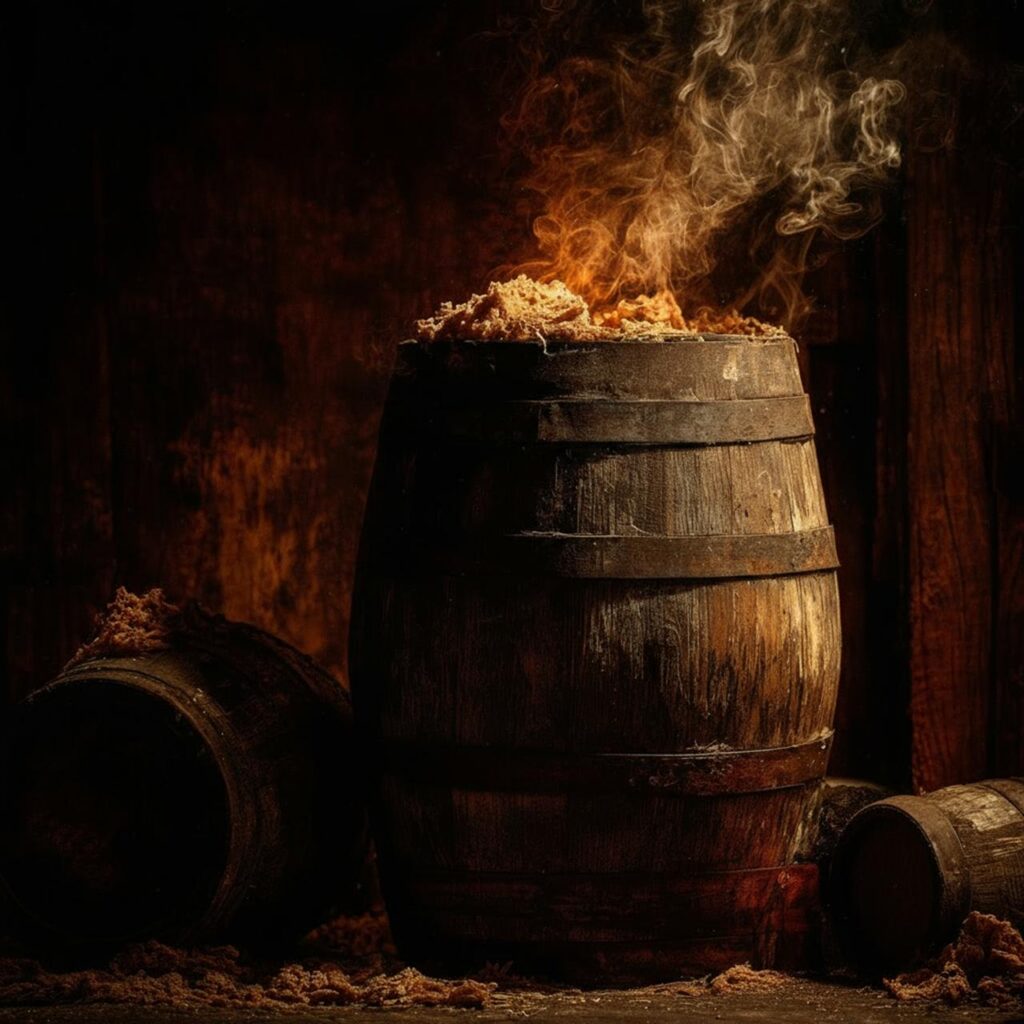The term “angels’ share” (Russian: доля ангелов; French: la part des anges) originated as a poetic explanation for the alcohol lost during spirit maturation in wooden barrels. Early distillers observed that over time a portion of their liquor would mysteriously vanish from sealed oak casks. Unaware of the scientific cause, they whimsically concluded that angels must be sampling the spirits, taking their “share.” In reality, this is simply evaporation: as the spirit ages, alcohol (and some water) slowly seeps out through the pores of the oak, diffusing into the atmosphere.
Distillers eventually noticed a related phenomenon – a black, soot-like fungus thriving on the ethanol fumes near storage cellars. In the past, this “whiskey fungus” actually gave away the location of clandestine brandy producers: authorities could spot illicit cognac operations by the telltale dark mildew staining nearby walls and roofs. Nowadays, however, producers view the ebony coating as a badge of honor. Cognac makers in France proudly call it the “angels’ effect,” as a heavy fungal patina suggests a long-aged, high-quality spirit inside the casks.
Today the evaporation process is well-understood, and “angels’ share” remains a charming metaphor to describe the portion of a spirit that disappears during barrel aging. Essentially, it’s the inevitable loss of liquid while a spirit matures in oak. The effect is most pronounced in long-aged, high-proof beverages like whiskey or brandy (cognac), where years of maturation can significantly reduce volume. Just how much is lost to the angels? It depends greatly on storage conditions – especially climate. Here are a few examples of evaporation rates:
Whisky: In Scotland’s cool, humid climate, roughly 1–2% of a whisky barrel’s volume evaporates per year. In hotter, drier regions like Kentucky or Tennessee, the annual loss is higher (around 4%), and a young bourbon can lose up to 10% in its first year.
Rum: Tropical aging causes even greater losses, often about 7–10% per year. To mitigate this, some rum producers age their spirits in cooler places. For example, bulk Caribbean rum destined for brands like Captain Morgan is sometimes shipped to Scotland for maturation, taking advantage of the milder climate to reduce evaporation.
Cognac: In France’s Cognac region, the annual evaporation amounts to roughly 20 million bottles’ worth of brandy vanishing into the air. Over about six years of aging, a barrel may lose up to a quarter of its contents.
Overall impact: Across Scotland’s whisky industry, an estimated 45 million half-liter bottles evaporate each year as the angels’ share – roughly 22 million liters gone to the heavens. This substantial loss is the price of long-term aging (and partly why older whiskies are so expensive).
What Factors Influence the Size of the “Angels’ Share”?
Evaporation from a cask depends on a number of factors, including humidity and temperature, regional climate, the quality of the oak, barrel size, and aging duration.
Humidity and temperature play a major role. The drier the environment, the greater the evaporation. Warm air speeds up molecular movement, which accelerates both water and alcohol evaporation. In short: dry and warm = faster angels’ share.
Oak Quality and Barrel Size
Quality of Oak
The most important factor here is the density of the wood. A dense, tight-grained oak “breathes” more slowly and loses less spirit through evaporation. A looser, more porous oak allows greater loss under the same conditions. For example, Caucasian oak is about 2.5 times denser than common pedunculate oak, so barrels made from it lose less alcohol. Slavonian oak from Croatia is as strong as French oak but slightly coarser and denser.
Barrel Size
The smaller the barrel, the faster the evaporation, since a larger proportion of the liquid is in contact with the wood. For instance, the evaporation rate in 5-liter and 225-liter barrels differs roughly threefold. Naturally, the spirit can only evaporate through the wooden walls, so the smaller the barrel, the greater the annual loss. In a regular apartment, the loss can reach 20–25%. The angels’ share can climb as high as 40% per year if it’s a 3-liter barrel kept at +25°C and 20–30% humidity, filled with a 60% ABV distillate.
The Beverage
The type and strength of the liquid also matter. Stronger spirits evaporate faster than weaker ones, so wine evaporates much more slowly than a high-proof distillate. That’s why winemakers rarely worry about the angels’ share, while whiskey and brandy producers always account for it.

